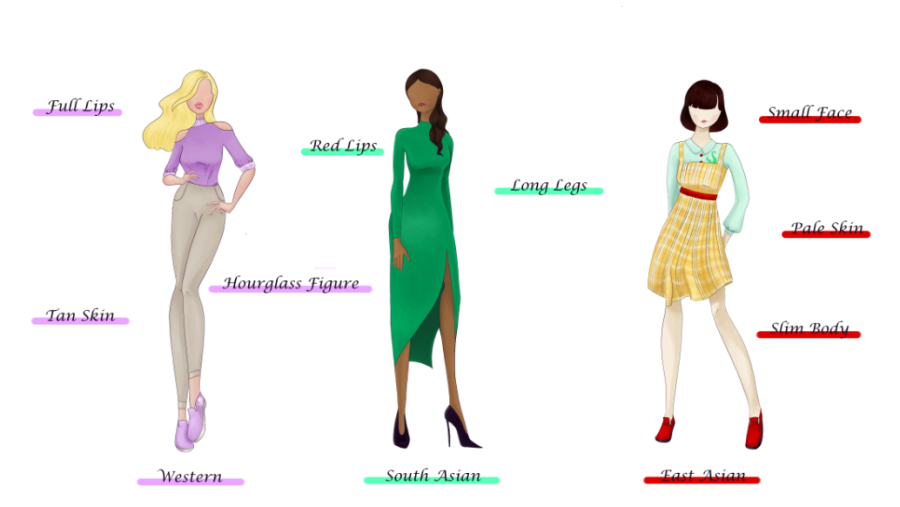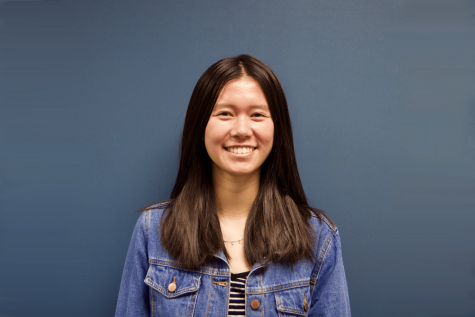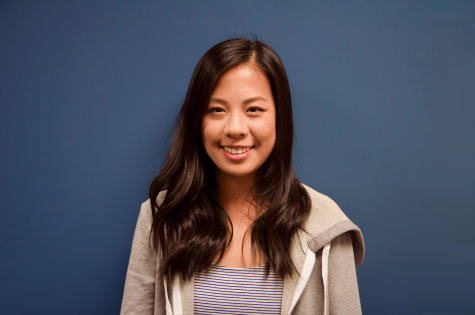Discovering beauty standards around the world
February 1, 2019
Broad hips, a curvy figure and youthful features — the epitome of beauty for many Western women according to a magazine poll on people’s ideas of beauty. Across the globe, however, completely different standards can be found. Double eyelids, a thin figure and porcelain pale skin is the typical ideal East Asian appearance. On the other hand, in South America, Latina women strive for long dark hair, slim but curvy bodies and an overall young yet seductive look according to Affinity Magazine. What is considered beautiful can vary from country to country.
“I would define ‘beauty’ as someone who is strong and inspiring, someone who is courageous and not afraid to be themselves,” said sophomore Austin Tong. “When people are able to be vulnerable and put themselves out there, it shows how strong they are and essentially their beauty. I love to see people when they stop caring about what others will say or think.”
Different cultural standards influence one’s perception of beauty. What many Chinese and Korean women strive for is known as “baifumei,” meaning pale and rich in Chinese. According to the Huffington Post, Chinese culture’s fixation on a pale complexion dates back to the Han dynasty, during which the feminine ideal was to have white skin. This ideal has continued to grow more prominent, with people using a variety of methods such as wearing protective clothing and using skin lightening products to guard their skin from tanning. According to the Medium, many Chinese men strive for a tall and skinny figure with few feminine characteristics. This desire is influenced by K-pop culture and Japanese anime, which depict many males with a more delicate image. Through K-pop and K-dramas, the “flower boy” look — used to describe a male with feminine features — became popularized and desired.
However, in modern Western cultures, someone who is tan, skinny with long legs and wide hips, big breasts and full lips is considered attractive. The Guardian traces the desire for tan skin in Britain back to the Industrial Revolution: impoverished people began working in factories, resulting in pale complexions that were associated with poverty. For men, the term “lumberjack” captures the desired appearance: a muscular body with facial hair. Western males focus more on what they can do to develop muscles, spending hours at the gym to achieve the look. A San Francisco State University study found that while women worked to stay skinny, men worked to become muscular.
Latina celebrities such as Sofia Vergara and Jennifer Lopez have set the standard for Latin American women. For Latinas, most women work for a curvy, younger and sexier look. According to the Latino Health and Beauty Care Market, Latinas are “significantly most likely” to spend the most money on beauty products such as makeup and perfume.
This idealization of a certain appearance can produce negative effects as people start obsessing over achieving what their society defines as beautiful. YWCA, a nonprofit women’s organization, reports that 40 percent of newly diagnosed cases of eating disorders are girls between the ages of 15 to 19; they also state that those who spent the most time perfecting their appearance are usually the ones with the least self-confidence.
“I’ve felt the need to lighten my skin for a long time, as women in my family would push lightening products on me,” said senior Vennela Chukka. “It took a lot for me to overcome that and realize that bleaching my skin would never detach me from my Indian identity.”
Today, social media platforms have extended the definition of “beauty” to a wider audience. While scrolling through Instagram, people are constantly viewing what their society tells them is beautiful or handsome. This can have a negative effect on the users as they begin playing comparison games, pointing out parts of their body they want to change. As a result, some people may resort to extreme diets or cosmetic surgery to achieve the idealized appearance.
“When we see that [a certain look] is getting lots of positive reinforcement, there’s an agency for us to go ‘oh, that’s good for me too,’” said Javier Galindo, an instructor of Popular Culture at De Anza College. “It’s similar to when people go to casinos, and the sound of money coming out of machines acts as reinforcers for continuing to gamble.”
Beauty standards date back several centuries but are also changing as times progress. What one sees as a physical flaw might be beautiful to another. It is important for each individual to remember not to get carried away with these ideals but rather to create his or her own definition of beauty and own it.





























































